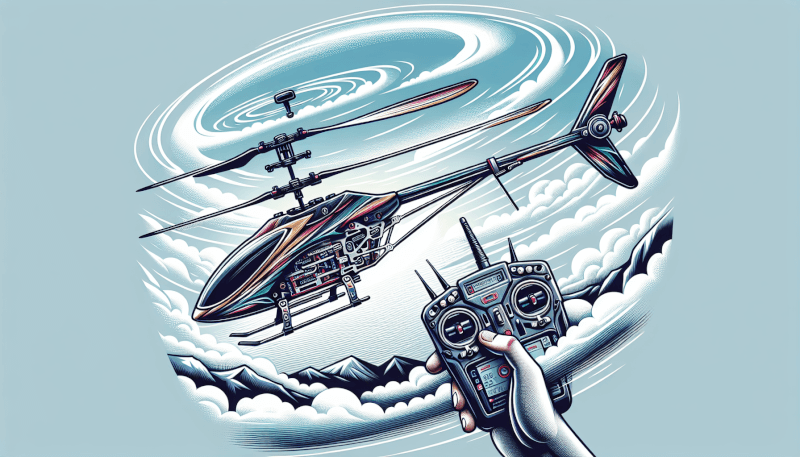In the world of remote control helicopters, improving your control and maneuverability skills is key to a thrilling flying experience. Whether you’re a beginner or a seasoned enthusiast, these 10 tips will help you take your RC heli skills to new heights. From mastering the basics of throttle control to fine-tuning your aerobatic maneuvers, this article will provide you with valuable insights and techniques to enhance your overall flying performance. So, buckle up and get ready to navigate the skies with confidence and precision!

Tip 1: Understand the basics of RC helicopter control
When it comes to RC helicopter control, it’s important to have a solid understanding of the basics. This includes mastering the controls, understanding the different parts of the helicopter, and knowing the various flight modes available.
Mastering the controls
The controls of an RC helicopter typically consist of four main inputs: the cyclic control, the collective control, the anti-torque control, and the throttle control. Each of these controls plays a crucial role in maneuvering the helicopter in the desired direction. Take the time to familiarize yourself with each control and practice using them individually to gain proficiency.
Understanding the different parts
Knowing the different parts of an RC helicopter is essential for effective control. Components such as the main rotor, tail rotor, swashplate, and servos all work together to ensure smooth flight. Educate yourself on the purpose and function of each part to better understand how to manipulate them for optimal control.
Knowing the flight modes
RC helicopters often come with different flight modes that cater to varying skill levels. These flight modes can include beginner, intermediate, and advanced settings. Understanding the differences between these modes and knowing when to progress from one to another will greatly enhance your control and maneuverability as you advance in skill.
Tip 2: Choose the right RC helicopter for your skill level
Selecting the appropriate RC helicopter for your skill level is crucial for an enjoyable and successful flight experience. Consider your level of experience, the size and type of helicopter, and spend time researching and reading reviews before making a purchase.
Consider your experience
If you are a beginner, it is advisable to start with a helicopter specifically designed for beginners. These models typically have stability features and simplified controls to assist in the learning process. Intermediate and advanced pilots can opt for helicopters with more advanced features and maneuverability.
Select the appropriate size and type
RC helicopters come in various sizes and types, such as micro, mini, and 3D helicopters. Smaller helicopters are generally more suitable for indoor flying, while larger ones are better for outdoor environments. Consider where you plan to fly and choose a size that matches your intended flying area.
Research and read reviews
Before purchasing an RC helicopter, it’s essential to research different models and read reviews from other users. This will provide valuable insights into the features, performance, and durability of the helicopters you are considering. Take the time to compare different options and choose a helicopter that aligns with your skill level and flying preferences.
Tip 3: Master the art of throttle control
Throttle control is a fundamental skill that plays a significant role in RC helicopter flight. Understanding the basics of throttle control, practicing throttle management, and utilizing throttle curves will greatly enhance your control and maneuverability.
Learning the throttle basics
The throttle control determines the power and altitude of your RC helicopter. It’s essential to learn how to smoothly control the throttle to maintain stability during flight. Begin by practicing gradual throttle adjustments to achieve a steady ascent and descent, and gradually increase your speed and altitude as you gain confidence.
Practicing throttle management
Once you grasp the basics of throttle control, it’s important to practice throttle management. This involves maintaining a consistent throttle input to prevent abrupt changes in altitude or speed. Smooth and controlled throttle adjustments will result in more precise and stable flight.
Utilizing throttle curves
Throttle curves are features found in more advanced RC helicopter systems that allow you to customize the throttle response based on your preferences. Experiment with different throttle curve settings to find the right balance of power and responsiveness for your flying style. This customization can greatly improve your control and maneuverability.
Tip 4: Focus on mastering hover and stability
Mastering hover and stability is crucial for performing precise maneuvers and maintaining control throughout your flight. Understanding the importance of hover, achieving stability through practice, and utilizing trim adjustments will help you achieve this level of control.
Understanding the importance of hover
Hovering is the foundation of all RC helicopter flight. It involves maintaining a stable position in mid-air without any noticeable movement. Mastering hover allows you to perform other maneuvers accurately and smoothly. Take the time to practice hovering at various heights and orientations to develop a solid foundation for your flying skills.
Achieving stability through practice
Stability is key when it comes to RC helicopter control. Practice maintaining a stable hover and steady flight by making small and precise adjustments as needed. This will help you develop a good feel for your helicopter’s behavior and improve your ability to correct any unwanted movements.
Utilizing trim adjustments
Trim adjustments are small tweaks made to the control inputs to counteract any unwanted drift or imbalance. When hovering, you may notice that your helicopter tends to drift in a particular direction. Use the trim adjustments on your transmitter to correct these minor imbalances and achieve a more stable hover. Regularly check and adjust the trim settings as needed to maintain optimal stability.

Tip 5: Learn the different flight maneuvers
To enhance your control and maneuverability, it’s important to learn a variety of flight maneuvers. Mastering basic maneuvers, practicing advanced maneuvers, and exploring 3D flight techniques will expand your capabilities as an RC helicopter pilot.
Mastering basic maneuvers
Start by mastering basic maneuvers such as forward flight, backward flight, left and right turns, and figure-eights. These maneuvers will help you develop a good understanding of the controls and build your confidence as a pilot.
Practicing advanced maneuvers
Once you are comfortable with the basic maneuvers, challenge yourself by practicing more advanced maneuvers such as loops, rolls, inverted flight, and stall turns. These maneuvers will push your skills and broaden your flying capabilities. Remember to practice in a safe area and gradually build up to these more complex maneuvers.
Exploring 3D flight techniques
For pilots seeking an extra level of excitement, exploring 3D flight techniques can take your control and maneuverability to new heights. This includes maneuvers like tic-tocs, piro flips, and hurricanes. 3D flight techniques require precise control inputs and a deep understanding of your helicopter’s capabilities. Start with simpler 3D maneuvers and gradually progress as you become more comfortable.
Tip 6: Practice orientation and spatial awareness
Developing strong orientation and spatial awareness skills is essential for maintaining control and maneuverability throughout your flights. Understanding different orientations, improving spatial awareness, and training with orientation aids will help you achieve this.
Understanding different orientations
An RC helicopter can appear differently depending on its orientation relative to the pilot. Practice hovering and flying in various orientations such as nose-in, tail-in, side-in, and inverted. By becoming familiar with these different perspectives, you’ll be able to confidently control your helicopter regardless of its orientation.
Improving spatial awareness
Spatial awareness involves understanding the position and movement of your RC helicopter in relation to its surroundings. It is crucial to avoid collisions and perform maneuvers accurately. Practice maintaining a mental map of your helicopter’s location and movement while keeping an eye on your surroundings. With practice, your spatial awareness will improve, allowing for more precise control and maneuverability.
Training with orientation aids
Orientation aids can be helpful tools for developing orientation and spatial awareness skills. These aids, such as colored rotor blades or stickers, can provide visual cues to help identify the front and back of your helicopter. Utilize these aids during practice sessions to reinforce your understanding of different orientations and improve your overall control.

Tip 7: Fine-tune your helicopter’s setup and settings
Fine-tuning your helicopter’s setup and settings can greatly enhance its performance and control. Balancing the rotor system, adjusting control linkage, and optimizing gyro settings are important aspects to consider.
Balancing the rotor system
Balancing the rotor system ensures smooth flight by minimizing vibrations. Check the balance of the main rotor blades and tail rotor blades to ensure they are evenly weighted. Make necessary adjustments or use balancing tools to achieve optimal balance, resulting in improved control and maneuverability.
Adjusting control linkage
Control linkage refers to the mechanical connections between the servos and the various control surfaces of your RC helicopter. It’s important to ensure proper alignment and tension in these linkages to achieve precise control. Regularly inspect and adjust the control linkage to eliminate any unwanted slop or binding, which can hinder control and maneuverability.
Optimizing gyro settings
The gyro, or gyroscopic flybarless system, plays a significant role in stabilizing your helicopter. Adjusting the gyro settings can fine-tune its responsiveness and stability. Experiment with different gyro gain settings to find the optimal balance for your flying style. Properly optimized gyro settings will result in improved control and maneuverability.
Tip 8: Utilize dual rates and exponential settings
Dual rates and exponential settings are features found in many transmitters that can greatly enhance your control and maneuverability. Understanding dual rates and expo, setting up dual rates for different flight modes, and adjusting expo for smoother controls are key aspects to consider.
Understanding dual rates and expo
Dual rates allow you to adjust the sensitivity of your control inputs. Higher rates provide quicker and more responsive movements, while lower rates offer a more docile and forgiving response. Expo, short for exponential, allows you to fine-tune the response curve of your controls, making them less responsive around the neutral position. This enables smoother control inputs and reduces the risk of over-correction.
Setting up dual rates for different flight modes
Depending on your skill level or the type of maneuver you’re attempting, you may want to have different control sensitivity. Setting up dual rates for different flight modes enables you to switch between different levels of control responsiveness on the fly. For example, you might want higher rates for advanced maneuvers and lower rates for more stable flight. Experiment with different dual rate settings to find the ideal balance for each flight mode.
Adjusting expo for smoother controls
Adjusting expo can help fine-tune the feel of your controls. By utilizing expo, you can make your control inputs less sensitive around the neutral position, giving you more precise control during finer movements. Experiment with different expo settings to find the level of control smoothness that suits your flying style.

Tip 9: Invest in a quality transmitter and receiver system
A quality transmitter and receiver system are essential for reliable control and maneuverability. Choosing a reliable transmitter, opting for a compatible receiver, and understanding transmitter features will greatly enhance your flying experience.
Choosing a reliable transmitter
Investing in a reliable transmitter is crucial for consistent control and a stable connection with your RC helicopter. Look for transmitters from reputable brands that offer a wide range of features and compatibility options. Consider your budget and future flying aspirations when choosing a transmitter, as a quality transmitter can significantly improve your control and maneuverability.
Opting for a compatible receiver
Ensure that the receiver you choose is compatible with your chosen transmitter and RC helicopter. Different brands and models may have specific compatibility requirements, so it’s important to do your research and select a receiver that is compatible with your chosen setup. A compatible receiver will ensure reliable communication between your transmitter and RC helicopter, resulting in improved control and maneuverability.
Understanding transmitter features
Transmitters come with various features that can enhance your control and maneuverability. Features such as programmable mixes, model memory, and telemetry capabilities offer greater customization and control. Take the time to familiarize yourself with the features of your transmitter and explore how they can enhance your flying experience.
Tip 10: Continuous practice and improvement
The key to becoming a proficient RC helicopter pilot is continuous practice and improvement. Setting aside regular practice time, experimenting with new techniques, and seeking guidance and learning resources will help you progress and refine your control and maneuverability skills.
Setting aside regular practice time
Consistency is key when it comes to practicing RC helicopter control. Set aside dedicated practice time on a regular basis to ensure you have ample opportunities to refine your skills. Whether it’s a few minutes each day or longer sessions a few times a week, regular practice will help you build muscle memory and improve your control and maneuverability.
Experimenting with new techniques
Don’t be afraid to step out of your comfort zone and experiment with new techniques and maneuvers. Trying out different flight patterns, practicing challenging maneuvers, and pushing the limits of your skills will accelerate your progress as a pilot. Embrace the learning process and continue to challenge yourself to improve your control and maneuverability.
Seeking guidance and learning resources
There is a wealth of knowledge and resources available to help you improve your RC helicopter control and maneuverability. Online forums, instructional videos, and local RC clubs are great sources of guidance and support. Engage with experienced pilots, seek their advice, and absorb as much information as you can to enhance your skills. Remember, learning is a continuous journey, and seeking guidance will help you refine your control and maneuverability for years to come.
In conclusion, mastering RC helicopter control and maneuverability requires a combination of understanding the basics, choosing the right equipment, practicing throttle control, focusing on hover and stability, learning different flight maneuvers, enhancing orientation and spatial awareness, fine-tuning setup and settings, utilizing dual rates and expo, investing in quality equipment, and continuous practice and improvement. By following these tips and dedicating time to honing your skills, you’ll become a confident and skilled RC helicopter pilot. Happy flying!



